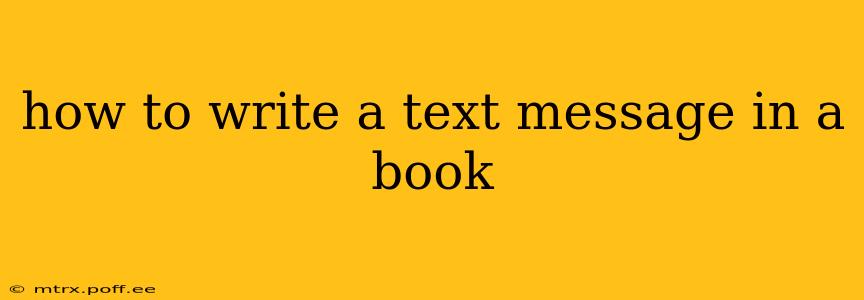How to Write a Text Message in a Book: A Guide for Authors
Writing text messages within a book requires a delicate balance. You want to convey the message's content clearly while maintaining a natural reading flow and avoiding disruptions to the narrative. This guide will explore effective techniques and stylistic choices to seamlessly integrate text messages into your storytelling.
Choosing the Right Format:
The format you choose significantly impacts readability. Here are the most common options:
-
Indented Paragraphs: This is a simple, clean approach. Indent the text message like a dialogue, using a clear indicator to signal the sender (e.g., Liam:). This method is less visually distracting than others.
Liam: Hey, are you still coming tonight? Maya: Yeah, just running late. Be there in 20. -
Italics with Sender Identification: Use italics to set off the text message, similar to using italics for thoughts. Again, a sender identifier is essential.
Liam: Hey, are you still coming tonight? Maya: Yeah, just running late. Be there in 20.
-
Bold Text with Sender Identification: Similar to italics, but using bold text. This choice can work well if your book already uses italics extensively for other purposes.
Liam: Hey, are you still coming tonight? Maya: Yeah, just running late. Be there in 20.
-
Using a Speech Bubble Graphic: This option is primarily for graphic novels or books with visual elements. It adds visual interest but might not be appropriate for all genres.
Style and Tone:
Remember, text messages have a unique style. They often use:
- Abbreviations: Use abbreviations sparingly and only when appropriate for the character's voice and the overall tone. Avoid overusing them, as it can make the text difficult to read.
- Informal Language: Text messages typically use informal language, slang, and emojis (more on that below). This reflects real-life communication and adds authenticity.
- Character Voice: Ensure the text message reflects the character's personality and voice. A formal character wouldn't use the same language as a casual one.
Integrating Emojis:
Emojis can add expressiveness to text messages, but use them judiciously. Too many emojis can be distracting and feel out of place. Consider the following:
- Context: Only use emojis when they enhance understanding and add to the emotional tone.
- Character Appropriateness: A serious character might not use many emojis, whereas a playful one might.
- Reader Experience: Ensure your target audience will understand the emojis used.
Overuse and Readability:
Avoid lengthy text message exchanges. Too much text messaging can interrupt the narrative flow and bore the reader. Use them strategically to highlight key information, reveal character relationships, or advance the plot. If an extensive exchange is necessary, consider summarizing it or breaking it into smaller, more manageable chunks.
Frequently Asked Questions
How do I indicate when a text message is unread?
You can denote unread messages in various ways. A simple visual cue, such as adding "Unread" in parentheses after the message, is effective: (Liam: Hey, are you still coming tonight? (Unread)) Alternatively, you can use a different font style or color for unread texts.
Should I use real-world texting conventions like timestamps?
Timestamps aren't typically necessary in fiction. While they add realism, they often clutter the text and aren't essential to the story. Focus on conveying the message's content and emotional impact.
How can I avoid making text messages disrupt the flow of the narrative?
Keep the messages brief and relevant to the plot. Avoid overly long conversations. Use clear visual formatting to set them apart from the narrative, creating a natural separation. Prioritize messages that advance the plot or reveal character traits.
What if I need to include a picture or video in a text?
If a picture or video is essential to the plot, describe its content rather than attempting to replicate it in the text. This approach maintains readability and focuses on the narrative's impact.
By following these guidelines, you can successfully integrate text messages into your book, enriching the narrative while preserving a smooth and engaging reading experience. Remember, the key is balance and clarity. Choose the most appropriate style and use text messages sparingly, prioritizing the overall story's flow and impact.
